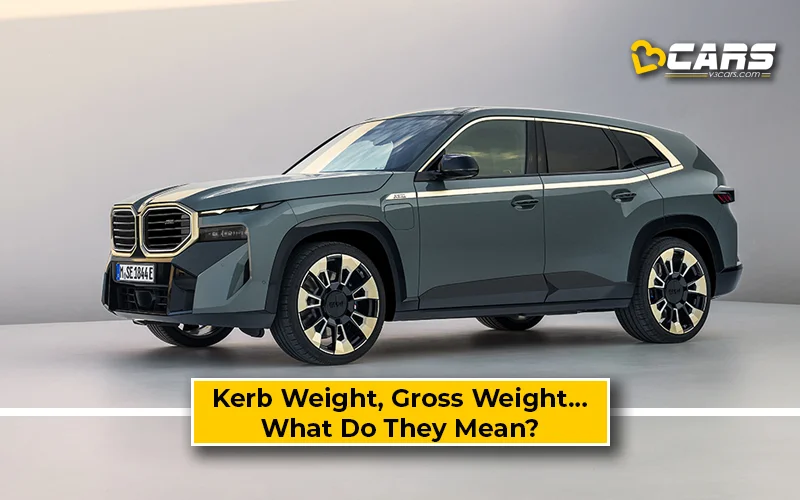What Is Kerb Weight, Gross Weight And Payload Capacity In Cars – V3Cars Guide
When you look through a car brochure or spec sheet, you’ll often find the vehicle’s weight mentioned in terms such as kerb weight, gross weight, unladen or dry weight and even payload capacity. These numbers can be confusing for a first-time car buyer. However, they tell you a lot about how a car performs, how much it can carry, and how efficiently it performs.

In this car guide, we’ll break down what each of these car weight terms means and how they affect your driving experience.
What Is Kerb Weight?
Kerb weight refers to the total weight of the car in running condition – with all standard equipment, fluids, and a full tank of fuel – but without passengers or luggage.
It’s basically what your car weighs when it’s parked by the kerb, ready to drive.
Why it matters:
- Affects acceleration and fuel efficiency. Lighter cars need less power to move.
- Helps you understand the car’s power-to-weight ratio, which indicates how quick and responsive it feels.
- Used by manufacturers to calculate the vehicle’s payload capacity.
Example: If a compact SUV like the Hyundai Venue weighs about 1,200kg (kerb weight), a heavier SUV with the same engine may feel slightly slower and use a bit more fuel.
What Is Gross Vehicle Weight (GVW)?
Gross Vehicle Weight (GVW) is the maximum permissible total weight of the vehicle when fully loaded, including passengers, luggage, fuel, and fluids. Manufacturers specify this limit to ensure safety and legal compliance.
Why it matters:
- Exceeding GVW affects braking, suspension, and tyre wear.
- Higher GVW means the car can carry more weight safely
Example: A car with a GVW of 1,750kg can legally and safely carry everything (car + occupants + luggage) up to that weight.
What Is Payload Capacity?
Payload capacity is the difference between the car’s GVW and its kerb weight. It shows how much total weight you can safely carry inside the car, including passengers and luggage.
Formula: Payload = Gross Vehicle Weight – Kerb Weight
Example: If a car’s GVW is 1,800kg and its kerb weight is 1,300kg, the payload capacity is 500kg.
That means the car can safely carry around 4–5 adults plus their luggage.
What Is Unladen Weight Or Dry Weight?
Unladen weight or dry weight is the car’s weight without fluids (fuel, coolant, oil, etc.) and without passengers or luggage. This is typically used more often in motorcycle specs or international markets, as Indian car brochures usually list kerb weight instead.
What Is Gross Combined Weight (GCW)?
Gross Combined Weight is the total permissible weight of a vehicle plus whatever it’s towing (like a trailer or caravan). This figure is mostly relevant for SUVs and pickup trucks that support towing. You’ll rarely find this term in regular hatchbacks or compact sedans.
Why Car Weight Figures Matter
Your car’s weight isn’t just a number – it directly influences how your car drives and feels.
- Performance: Heavier cars need more power to accelerate. Lighter cars feel quicker and more agile with the same engine size.
- Fuel Efficiency: More weight means more energy needed to move, reducing mileage.
- Safety & Stability: A heavier vehicle may feel more planted and stable at high speeds but might also have longer braking distances.
- Handling: Light cars turn more sharply, while heavier cars feel steadier on rough roads.
How to Find These Details
You can find your car’s kerb weight and GVW:
- On the manufacturer’s website or brochure
- A car’s registration certificate (RC) lists the unladen weight
Understanding kerb weight, gross vehicle weight, and payload capacity helps you read car brochures more accurately and choose the right car for your needs.
A lighter car may give you better fuel economy, while a heavier one can offer better stability and load-carrying ability.
Also Read: Top 10 Car Accessories Every Driver Should Have – V3Cars Guide
Helpful Tools:
Fuel Cost Calculator for Cars – Know your monthly fuel expense based on usage and mileage
Car On-Road Price Calculator – Convert ex-showroom to on-road price for any city
Sell Used Car Online – Enter your car and contact details to get an instant price estimate and book a free inspection with our partner network


0 Comments